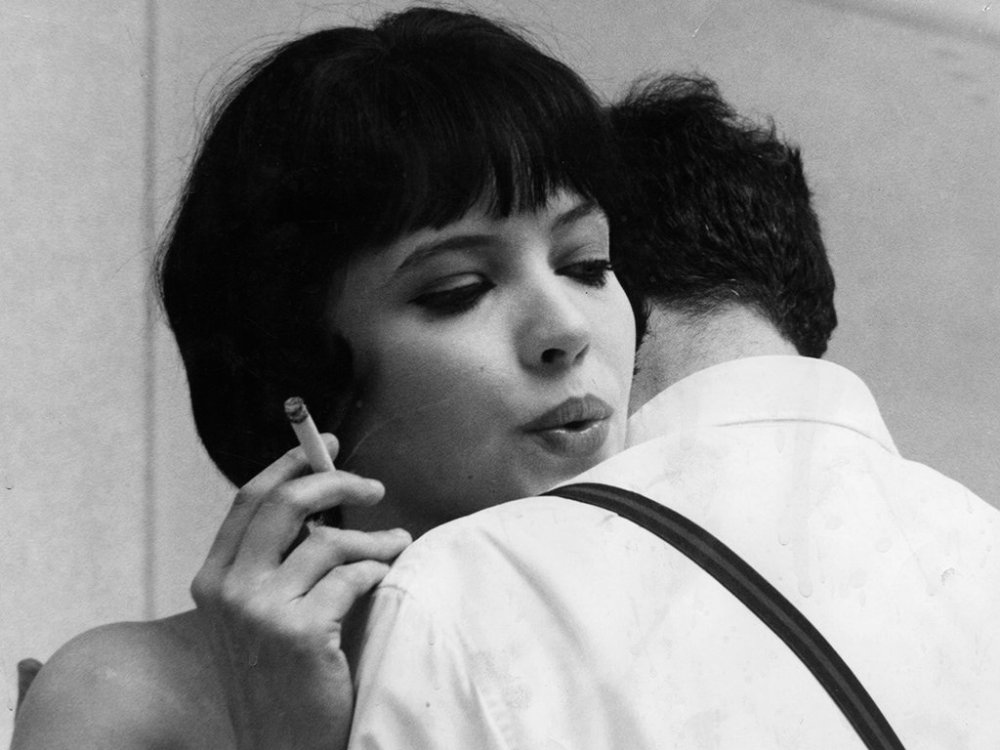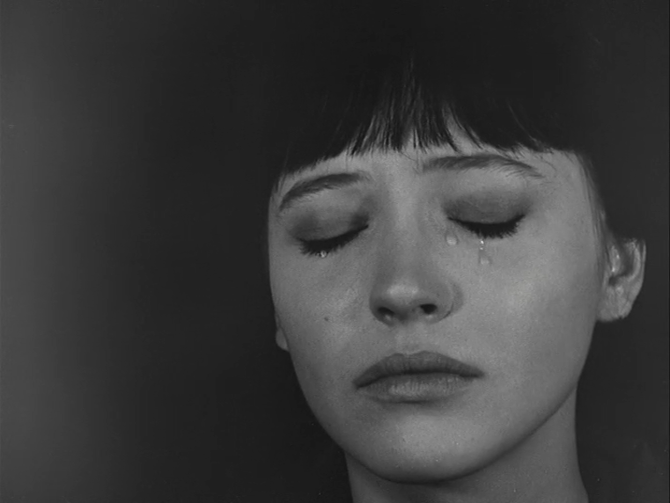I know what I want to say. I think first about whether they’re the right words. But when the moment comes to speak, I can’t say it.
This monologue is taken from the main character in Jean-Luc Godard’s film, Vivre sa vie (My Life to Live). The film is an experimental rumination on prostitution (much like The 400 Blows is a rumination — or exposé — of the mistreatment of incarcerated youth in the juvenile systems of France in its time) and at times it feels transcendent. I could be reading into things that aren’t there — perhaps it’s the remarkable “movie theater vigil” with The Passion of Joan of Arc that provides such a uniquely spiritual feeling to the film — but I find the entire thing grabs ahold of me and wrings my neck like a Dostoyevsky novel. It’s bitter, it’s philosophical, and it’s cold. [spoilers herein]

Anna Karina plays Nana Kleinfrankenheim, a woman who leaves her husband and child for a life she feels she should live. Moving to Paris to work and become an actress, Nana cannot make ends meet and regularly comes up short for the rent. Eventually she turns to prostitution, and it is here that her character dwells for the remainder of the movie.
One critique leveled against the film was that it trivialized the problem of prostitution. Personally I did not find this at all — especially after learning what a prevalent issue it has been in France — and I find it remarkable that anyone would think such a thing, particularly coming from Godard himself. Frieda Grafe — in an article translated by Gwendolyn Leick and republished at Vertigo Magazine — responds:
[…]would a statistical treatise about prostitution concern and reach anyone? In his film Godard has documentary material of the Parisian judge Sacotte read out aloud and the pictures that accompany these readings – showing Nana at work – are hardly of the kind to show the life of a prostitute in rosy colours or to soothe one’s conscience. That sort of thing has been shown in endless accounts of street-walkers, in which their world, more or less concealed, is presented to the bourgeois as a paradise at the fringe of bourgeois society.1
Turning now to music, Michel Legrand is responsible for the film’s score. His tragic musical theme is uniquely simple and unforgettable. This 1962 essay — written by Jean Collet and translated here by Royal S. Brown — is taken from La revue du son (a French news and culture magazine) and was extremely helpful to me in my understanding of how music was utilized and executed in Vivre sa vie. In the first place, Godard recorded all audio for the movie during filming, on a single track, without any dubbing of any kind. Collet continues:
One has to realize, however, that the soundtrack of Vivre sa vie represents the result of an extremely audacious experiment, a kind of challenge Godard kept in mind throughout the entire film. For not only was this film shot in natural settings, the soundtrack (both dialogues and noises) was also recorded directly. On a single track. This is no doubt the first sound film shot outside a studio and involving no sound editing. Almost the only mixing that was done was the addition of the music to a soundtrack recorded live during the shooting of the film.
Collet calls this “nothing less than revolutionary” and I have to agree. Considering the indisputable difficulty of recording not only dialogue and all of its nuances in the midst of a living and bustling atmosphere, but also coordinating a musical ensemble (of what size, I’m not sure) to play at just the right time and to be recorded in just the right way: this is indeed an incredible and revolutionary way forward. And Godard pulls it off perfectly, filming over the course of four weeks, and on a budget of a mere $40,000.

In the aforementioned movie theater scene, Nana watches The Passion of Joan of Arc and is moved to tears.2 Andrew Sarris sees this moment as soul defining, giving us the viewers a glimpse into Nana’s deepest recesses. Mark Cousins agrees:
Alone in the dark she looks up at the huge silent closeups of Falconetti as Joan, and cries. Godard reveals to us how human this woman is, not through showing her reaction to a real-life event, but by showing how moved she is by one of the most delicate moments in the art of silent cinema.3
The moment is unforgettable. It seems to be one of those beautiful moments in the history of cinema, when one filmmaker emphasizes something beautiful about another filmmaker’s film in their own production. Michael Atkinson, in his essay for the Criterion Collection says this:
Movie characters had watched films in darkened theaters before, but never had we been made to empathize so directly with the act of movie watching, and never before had that act meant so much. Watching both actresses, we are Karina, and for a brief time, we and Godard know exactly how she feels.
These are the moments that keep me coming back for more.
So what was the intent of Godard for making this film? Benefitting from retroactively making sense of this movie decades out from its release and following a long history of releases, we can easily say that Godard’s interest in this film seemed to lie in a sort of exposé. But unlike sweeter, more easy to swallow pills found in Hollywood or the like, Godard was exploring a plethora of other themes alongside his pursuit. But to touch on these themes would require a great deal of study on my part. At the moment, I have neither the time nor the commitment to make this trek. But perhaps someday.
Grafe again:
Stories about the tart with the golden heart proved that even in the most undignified circumstances human emotions can’t be suppressed. Nana dies at the end. Admittedly the manner of the end is not the most brilliant invention of the film. But if one takes this ending as a metaphor for the impossibility to live in such circumstances, it may well be justified. […] Godard hardly wanted to say with his film that prostitution is a profession like any other but rather that to lead a life one knows is unsuitable but carries on leading because of social considerations and fear of any effort and trouble amounts to a form of prostitution.4
If only Nana had been fortunate enough to have her own Travis Bickle to break things up.
Footnotes
1. Frieda Grafe’s first film review – her second published text – first appeared in Filmkritik 11/62. 6.Jahrgang, 11.Heft November 1962, 511-516. Reprinted in Frieda Grafe: Schriften, 4.Band, p.74-80, Berlin 2003 (edited by Enno Patalas).↩
2. Interestingly enough, Godard’s original plan was to have Nana watching not Dreyer’s Joan of Arc but Robert Bresson’s version of her life, The Trial of Joan of Arc.↩
3. Mark Cousins, The Story of Film, 273-4.↩
4. Frieda Grafe, Filmkritik 11/62. 6.Jahrgang, 11.Heft November 1962, 511-516. Reprinted in Frieda Grafe: Schriften, 4.Band, p.74-80, Berlin 2003 (edited by Enno Patalas).↩